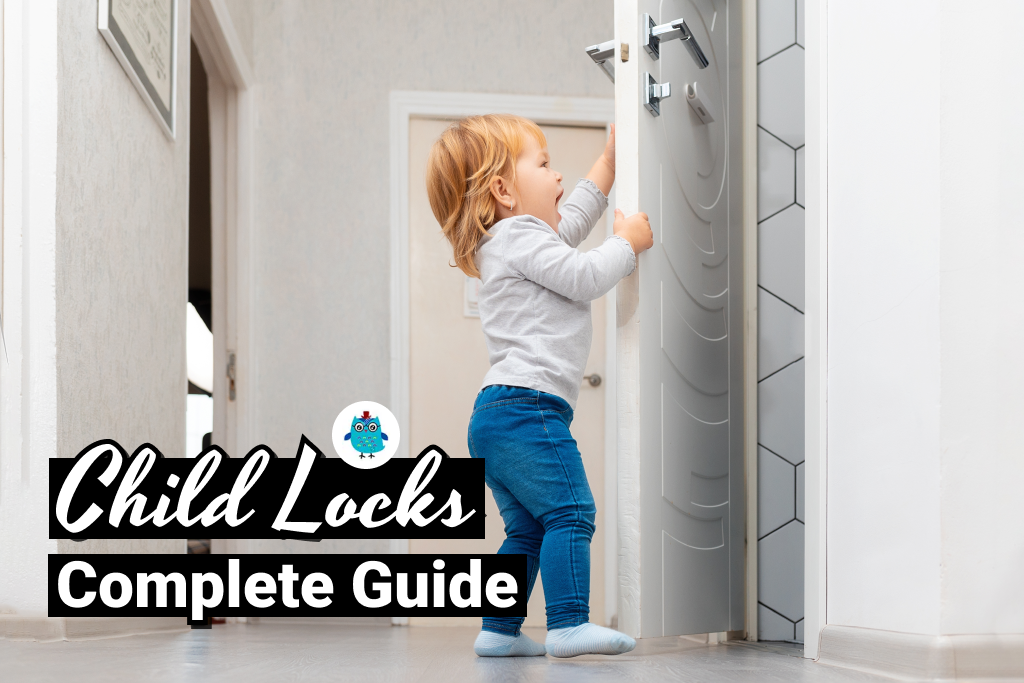A dad’s insight on how to keep your toddler from opening doors. From the basement to front doors and cabinets, here’s the best childproof safety lock to install. Don’t get any child locks before you read the following guide.
As a slightly anxious father of two little explorers, I know how nerve-wracking it can be to babyproof your home. Kids are curious, and if there’s a door in their sight, they want to know what’s behind it. Sometimes the danger is what’s back, and it could be the door itself that’s the threat. A closing door can do some severe damage to baby fingers. From front doors to interior ones, I’ll cover everything you need about childproofing doors, locks, and more.
My goal with this article is to help you understand how to:
- Childproof front doors and exterior doors with childproof deadbolts
- Stop toddlers from opening doors and unlocking front doors
- Secure interior doors, basement doors, and door knobs
- Choose the best childproof door locks and child safety locks for your home
- Lock doors without traditional locks for added safety
Plus, I’ll share personal stories about my own children’s door-related adventures (let’s say they’re pretty good at escaping).
This guide will cover the following type of doors:
Need more help?
So, let’s make our homes the safe havens our little adventurers deserve!
What Are the Door Child Proofing Essentials?
Selecting the right child lock can be confusing, don’t worry, I’ve been there! Here are the different types of child locks I have used at home or on vacation.
| Child lock | Price | More details |
|---|---|---|
| Doorknob covers | $$$$$ | Check price on Amazon |
| Sliding latch | $$$$$ | Check price on Amazon |
| Folding door lock | $$$$$ | Check price on Amazon |
| Pinch guard | $$$$$ | Check price on Amazon |
| Security lock | $$$$$ | Check price on Amazon |
| Patio door lock | $$$$$ | Check price on Amazon |
| Baby gate for doorway | $$$$$ | Check price on Amazon |
| Deadbolt lock | $$$$$ | Check price on Amazon |
With these, you are 100% sure to fully childproof your doors. However, sometimes, like when traveling, you need an alternative to real child lock products.
Childproof Your Doors: The Different Types of Door & Safety Child Lock
Regarding babyproofing your home, doors are a significant concern. The first one that comes to mind is the interior doors that lead to risky areas, such as the basement or garage. But there is also the front door that leads to the exterior or the pool area door that leads to even more danger. Let’s explore the various child lock to keep our little explorers safe.
Interior Doors: How to Keep a Toddler From Opening Doors
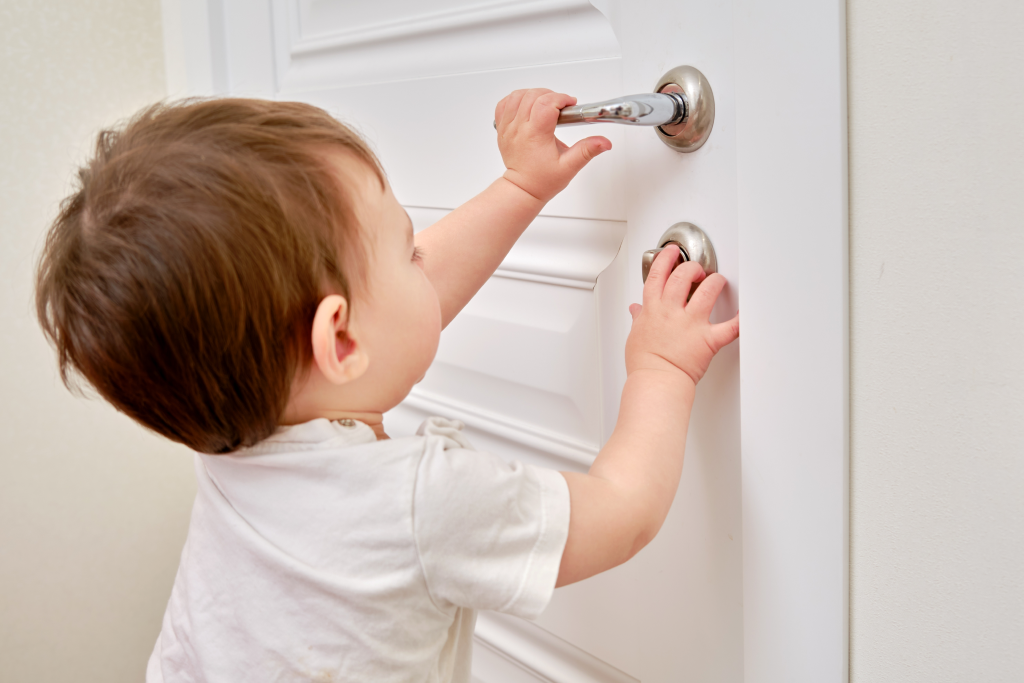
Kids, especially toddlers, are curious, and it’s a good thing. Our little explorer loves to open and close doors by themself. It’s cute until they catch their small fingers in the doors or the hinges.
From the basement door to a bedroom closet or any other room you don’t want your kid to enter, you have different options to childproof an interior door. It will prevent your kid from being injured or locked inside a room (trust me, this happens all the time with the bathroom door).
Hinged Doors: How to Childproof Them With Doorknob Covers and a Door Stopper
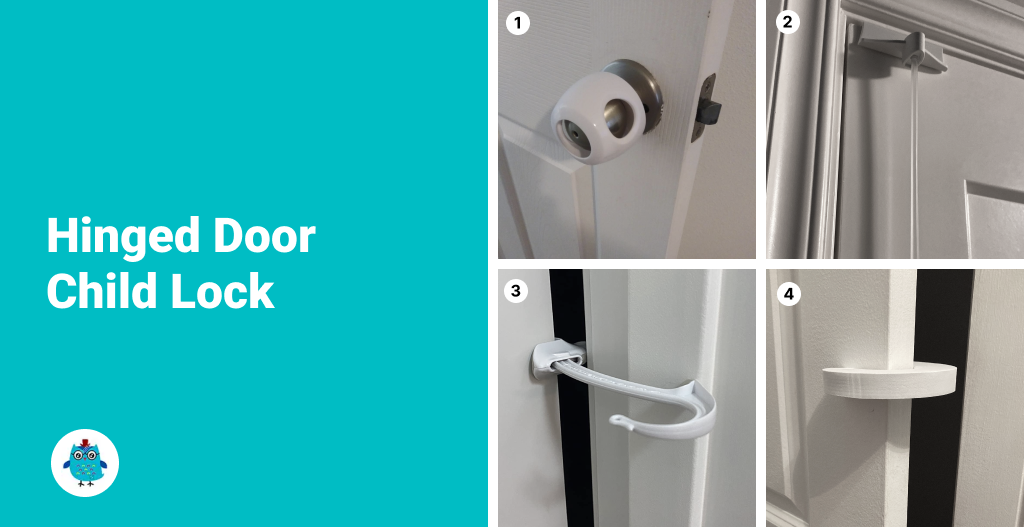
As a dad of two, I’ve learned that door knob covers, and pinch guards are essential for keeping my kids safe around these doors.
- Round Doorknob With Safety Covers: They are standard and work with the most rounded doorknob models. This unlocking process can be challenging for anyone with less dexterity or grip. However, your little James Bond will probably figure out how to escape after a while. Those locks will likely become useless when your kid reaches 3 or 4 years old. Different manufacturers will have various systems to stop your kid from opening the door. But I found this model on Amazon that I like.

- Top Door Lock: Maybe your kid is strong enough to open the door with a simple plastic cover. This door lock (link to Amazon) is placed at the top of the door, between the door frame and the actual door. You must install a peg into the door frame and use the sliding latch to lock the door. If you want to enter the room, slide the latch off the peg. It’s pretty simple and effective. Because it’s made of plastic, any adult could break it off in an emergency.
- The Door Monkey: I particularly like this product’s versatility (link to Amazon). It keeps the door from closing while holding the door close. The plastic mechanism looks like a monkey tail, fixed to the door frame and clamped to the actual door. Unclamp the mechanism with your finger to go through the door and push the door open. It’s very similar to the clamp used for babyproofing cabinets and drawers.
- Foam stopper – Door Monkey alternative: To prevent the door from fully closing, use a foam stopper (link to Amazon). It’s a U-shaped piece of foam that you clamp on the side of the door. The foam piece will stop the door from closing tight. Foam stoppers are a good solution for pet owners. It will allow your pet to circulate in the house without getting trapped by a closed door.
- DIY Round Doorknob Covers: I found a DIY doorknob cover
 that is the perfect temporary solution. You can create your version of the rounded doorknob cover with an old sock and a rubber band. An alternative to the sock is to use a cardboard toilet roll around the doorknob. Make sure you cut off the roll to keep just enough to cover the knob. If your toddler tries to grab the doorknob, it will slide around.
that is the perfect temporary solution. You can create your version of the rounded doorknob cover with an old sock and a rubber band. An alternative to the sock is to use a cardboard toilet roll around the doorknob. Make sure you cut off the roll to keep just enough to cover the knob. If your toddler tries to grab the doorknob, it will slide around. - Door With a Lever Handle: Maybe the interior door at your house has lever handles instead of round knobs. Well, there is also a way to childproof this type of door. Like the round doorknob plastic cover, there’s a product design to cover a lever handle. But, it needs to be secured to the door with screws or adhesive tape.
- DIY top door lock: This DIY solution is not pretty but could do the job for a temporary door lock. You only need to toss a washcloth over the top of the door so that it will hang on both sides. Fully close the door by giving an extra push. Test and see if the door is correctly jammed in place. If not, try to fold the washcloth to make it thicker. Now the door needs an extra push to be open. If it opens toward you, pull on the washcloth and the door handle at the same time.
- Key Lock: I recommend not locking doors inside your house! The key lock is a bad idea because, in an emergency, the key could be lost, and you might need to break the door. I remember visiting my uncle when I was about 6 years old, and I got locked inside a bedroom for a long time. He had vintage lock handles. You know, the one with the old key. He always kept the key inside the lock, but I decided to play with it that day. My parents had to search the house for at least 45 minutes. I was hysteric on the other side of the door. Today, I still remember that night correctly.
- DIY Door Stopper: You can make your version of the foam stopper by using a pool noodle. Just cut a piece and slide it on the side of the door. Another temporary solution is throwing a towel on the door directly. It will prevent the door from closing. Just ensure your kid can’t grab the towel to pull it off.
Sliding Door: How to Secure Your Closet and Shower Doors
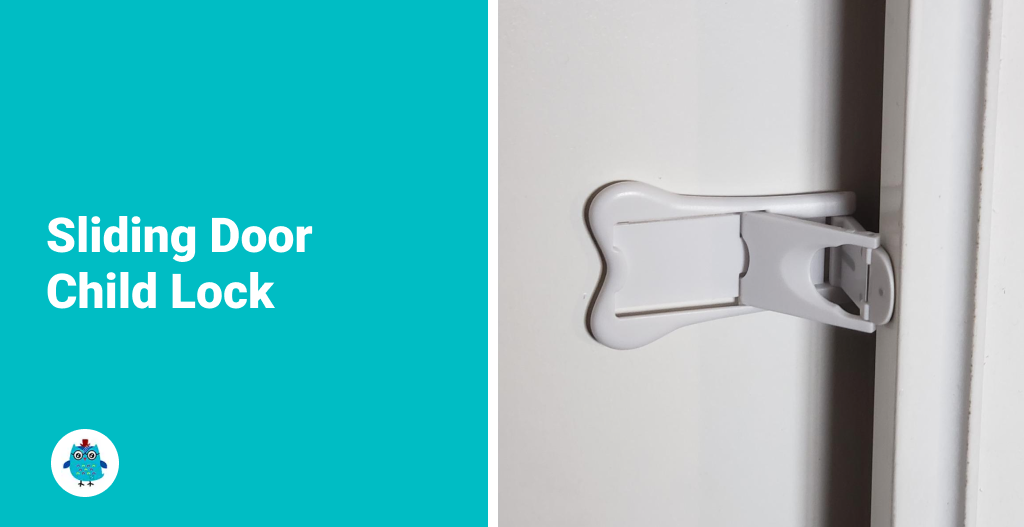
Sliding doors can be tricky to childproof, but don’t worry, I’ve got you covered. With the right lock, we can keep our curious little ones from venturing outside or getting their tiny fingers pinched.
You can use this simple lock for all sliding doors, like wardrobes, closets, glass, showers, etc. (link to Amazon) . There’s no need for screws; you can install them on any surface. It will prevent the door from completely opening. You merely need to press the button to unlock the door. Place it high enough so it is out of your children’s reach.
. There’s no need for screws; you can install them on any surface. It will prevent the door from completely opening. You merely need to press the button to unlock the door. Place it high enough so it is out of your children’s reach.
Folding Doors: How to Keep Your Child from Inside the Pantry
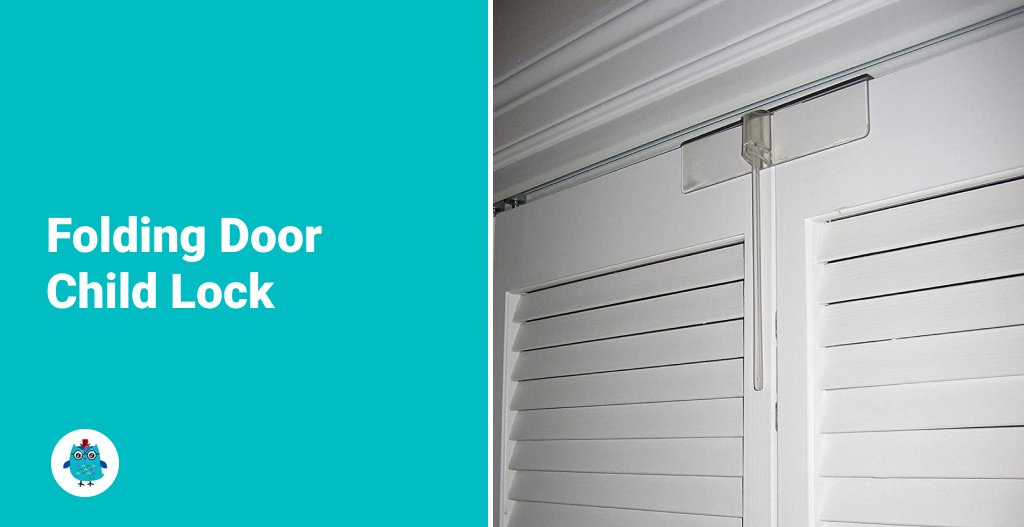
Some houses have folding doors, especially for small closets. I was surprised to learn that an especially designed child lock exists for this type of door (link to Amazon).
It’s relatively easy to use. You slide the lock between both doors, and it will prevent the doors from folding. To access the closet, you push the lock with one hand.
Because they are installed on top of the door, they will be effective until your kid is tall enough or learn to climb on something to reach it.
Cabinet Doors: How to Child Proof Your Kitchen and Bathroom Cabinet Doors
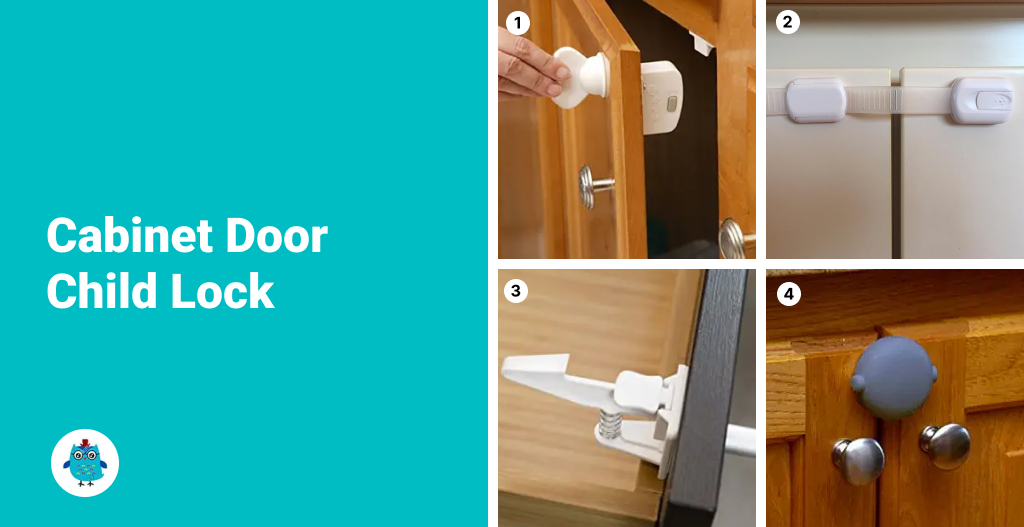
Cabinet doors are a treasure trove of potential hazards. Using the following techniques, you can keep your kids away from harmful items like cleaning supplies and sharp objects.
When childproofing a house, the new parents will start with the kitchen cabinets. It’s an excellent idea but remember the bathroom cabinets too.
Your child may not be crawling right now, but it could happen sooner than you think. Don’t postpone this task because there’s a good chance you won’t have time later, or you may wait until it’s too late.
Every year, almost 800 000 children go to the ER because they ingested cleaning products or medicines.
Before you buy the first childproofing product you see in the store, you must know they are not all user-friendly. In my experience, the first model of cabinet lock we installed was so frustrating to use. Since it was already fixed in place, I didn’t want to replace them, but I want you to avoid making the same mistake.
Let’s review the list of 7 different types of cabinets and drawers you must childproof.
- Magnetic Safety Locks: I believe magnetic safety
 locks (link to Amazon) are the most aesthetic option to childproof your cabinets. Because they are invisible (almost), you unlock the door using a magnetic key that moves the device behind the cabinet doors. Because the door completely locks, your kids cannot pinch their fingers while playing with the cabinet doors.
locks (link to Amazon) are the most aesthetic option to childproof your cabinets. Because they are invisible (almost), you unlock the door using a magnetic key that moves the device behind the cabinet doors. Because the door completely locks, your kids cannot pinch their fingers while playing with the cabinet doors. - Strap Locks: If you are looking for a temporary childproofing solution, the adhesive cabinet locks (link to Amazon)
 are the ones you need. Perfect for people who are renting or anyone who doesn’t want to drill holes in his expensive cabinet doors. Just be aware that your toddler will probably figure out how to open it at some point. Also, fix them correctly because they tend to unstick after a while.
are the ones you need. Perfect for people who are renting or anyone who doesn’t want to drill holes in his expensive cabinet doors. Just be aware that your toddler will probably figure out how to open it at some point. Also, fix them correctly because they tend to unstick after a while. - Spring Action Locks: This is the most common model of childproofing lock (link to Amazon)
 you will see among other families. To unlock the door, you must open it enough to reach the lock inside the cabinet with your fingers. However, most parents I know using this system had to replace them after their toddlers easily figured out how to open them. The lock is easy to open, but if you don’t let your kid watch how you do it, you should be ok for a year or two. Also, In my experience, the installation is challenging because you need to pre-drill tiny holes inside your cabinets.
you will see among other families. To unlock the door, you must open it enough to reach the lock inside the cabinet with your fingers. However, most parents I know using this system had to replace them after their toddlers easily figured out how to open them. The lock is easy to open, but if you don’t let your kid watch how you do it, you should be ok for a year or two. Also, In my experience, the installation is challenging because you need to pre-drill tiny holes inside your cabinets. - Adhesive Lock for Double Cabinet Doors: If you only need to childproof the space under your kitchen sink, this solution is for you (link to Amazon)
 . In my experience, this particular section in my kitchen contains the dishwasher tablets and other soaps. It’s one of the cabinet doors I first thought to be childproof. If you are worried about the look, like I am, you will appreciate the color options and the minimalistic design of the lock.
. In my experience, this particular section in my kitchen contains the dishwasher tablets and other soaps. It’s one of the cabinet doors I first thought to be childproof. If you are worried about the look, like I am, you will appreciate the color options and the minimalistic design of the lock. - Slide Locks for Side-by-Side Doors: Anther solutions to childproof side-by-side cabinet doors are slide locks (link to Amazon)
 . It looks like a U-shaped bicycle lock and works the same way. No installation is required, and you can remove them entirely at any time. This is why they are the perfect childproofing system when you are traveling. Next time you rent an Airbnb with your family, bring your slide lock with you.
. It looks like a U-shaped bicycle lock and works the same way. No installation is required, and you can remove them entirely at any time. This is why they are the perfect childproofing system when you are traveling. Next time you rent an Airbnb with your family, bring your slide lock with you. - DIY Slide Lock Alternative: If your cabinet doors have knobs, you can wrap a rubber band tight around both. It can be a broccoli rubber band or a hair rubber band. Find one that is thick enough and not too long. Just make sure to put it back in place every time. Don’t let the rubber band in your kid’s reach. He could try to chew on it, and to swallow the rubber band is a sure visit to the ER.
- Pull Cord Locks: If you like a bolo tie look, the pull cord is for you! Give your kitchen a Western look 🙂 I love Western movies, but not so much the pull cord locks. Yes, they are very simple, but it won’t take long before your toddler figures out how to open them. Instead, you could use a shoelace, and it will do the same job.
For more information on child locks for cabinets, check out this guide I created about babyproofing your cabinet doors and drawers.
While you are childproofing the kitchen, you must also consider the appliances.
Appliance Doors: How to Keep Your Toddler From Opening The Washer
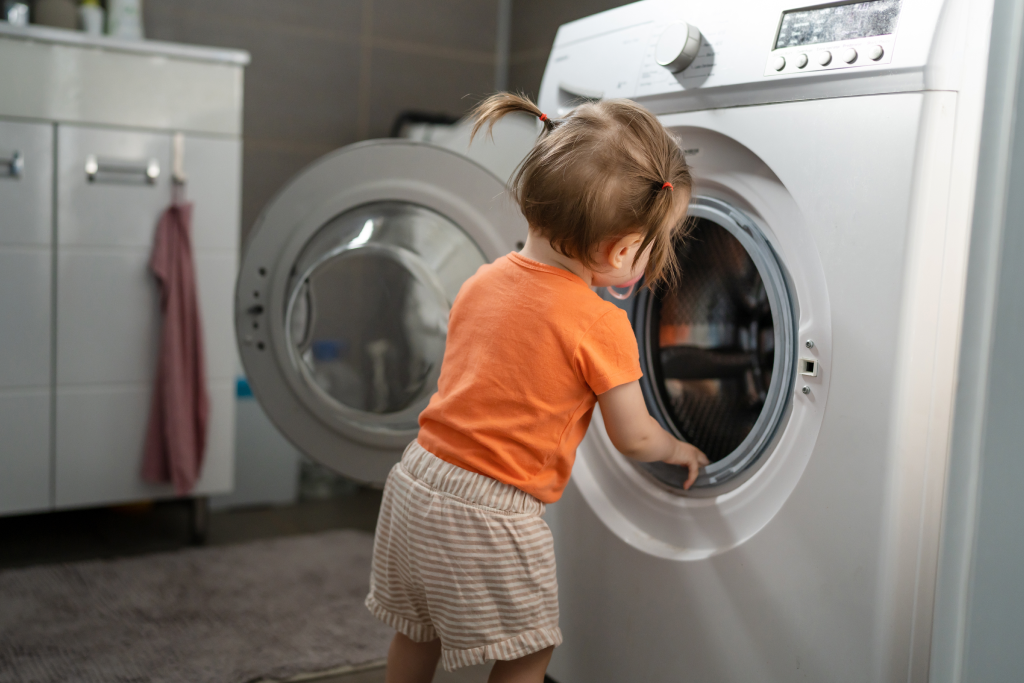
Kids love to play with doors, and appliances could look like big toys. The refrigerator is the most interesting one to open, and it could lead to a broken pickle jar on the floor. Also, the dishwasher could contain dangerous items, like knives and detergent tablets.
To thoroughly proof your home, consider adding a locking system to your refrigerator, washing machine, and microwave.
I recommend using the same adhesive strap lock mentioned above (link to Amazon) . These straps are easy to install and remove. No drilling require.
. These straps are easy to install and remove. No drilling require.
To open the door, you remove the strap, and you can leave it open for the time needed. When you are done, you slide the strap into the lock position.
Exterior Doors: How to Stop Children From Unlocking the Front Door
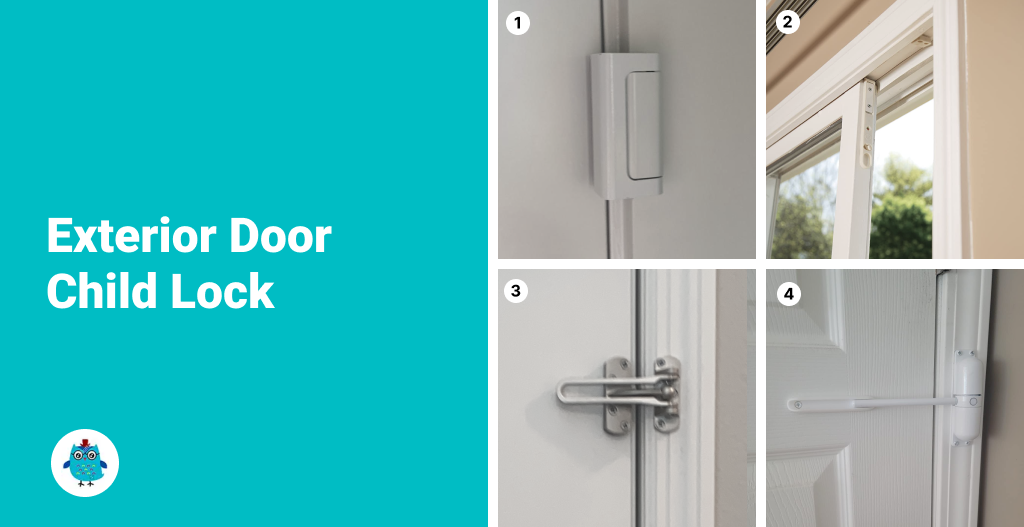
If your toddler is feeling adventurous and wants to go outside, you must do something about it. Now and then, we hear a story about a kid wandering around the neighborhood in the middle of the night or a baby crawling through a street. The consequences are too severe not to childproof your front door.
- The door guardian: This product served as a security lock (link to Amazon)
 , making it impossible to open the door from the outside. It was created to prevent forced entry, but many families use it as a childproofing solution. It’s perfect for blocking access to a back door, a garage door, or a balcony door.
, making it impossible to open the door from the outside. It was created to prevent forced entry, but many families use it as a childproofing solution. It’s perfect for blocking access to a back door, a garage door, or a balcony door. - Patio door lock: This type of lock (link to Amazon)
 is a plastic piece inserted into the track of the door frame. The door won’t open more than 3 inches when locked in place. It’s perfect for keeping your baby inside the house and the fresh breeze coming in.
is a plastic piece inserted into the track of the door frame. The door won’t open more than 3 inches when locked in place. It’s perfect for keeping your baby inside the house and the fresh breeze coming in. - Security door chain or latch: If you have a security door chain (latch is even better) on your front door, it’s a good start. If you don’t have one, it may be time to install one. What I like about this kind of door lock
 is its versatility. First, it’s meant to keep the intruder out of the house, but it’s also good to keep your toddler inside the house 😉
is its versatility. First, it’s meant to keep the intruder out of the house, but it’s also good to keep your toddler inside the house 😉 - Automatic door closer: Your exterior door should have an automated closing system, like this one
 , for maximum security. You or your guests will probably forget to close the door completely. The mechanism can be a hydraulic pressure closing system or a simple spring. No need to break the bank to have an automatic door closer.
, for maximum security. You or your guests will probably forget to close the door completely. The mechanism can be a hydraulic pressure closing system or a simple spring. No need to break the bank to have an automatic door closer. - Basic door hook and flip latch: The door hook is the most common locking system used for a sliding door. They can be found at any hardware store and come in various styles. Since you need to screw into the door frame and the actual door, I would recommend using this solution with a wooden door only. It works fine with french doors or pocket doors.
Pool Doors: How to Secure the Pool Area Like a Pro?
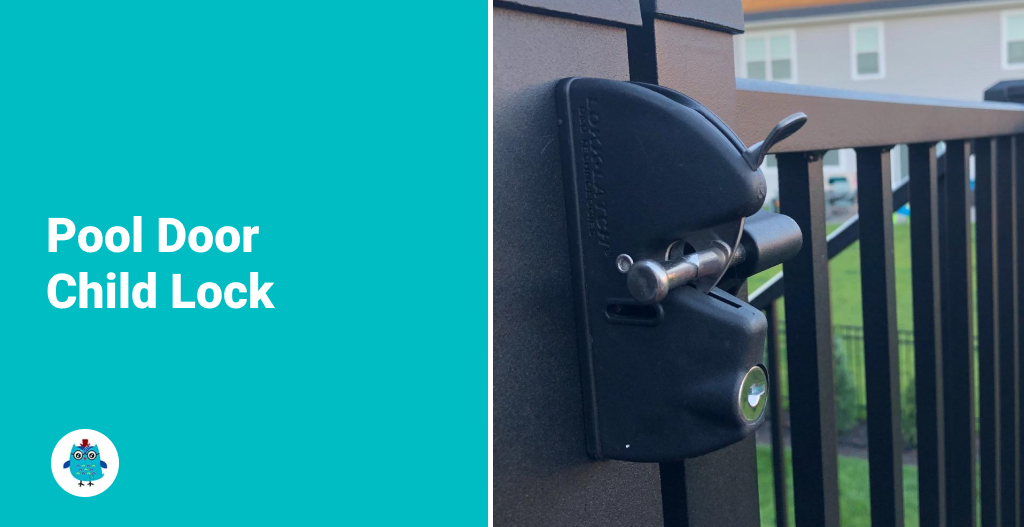
In most cities, the law requires that all pools be securely fenced. The door to the pool must have a lock mechanism and an automatic closer to be 100% childproof. If you only secure one door at your house, this is the one.
I suggest you get a key lockable latch like this one sold on Amazon . It’s the lock I got for my house, and it still works perfectly after 6 years.
. It’s the lock I got for my house, and it still works perfectly after 6 years.
To safely install a lock on a pool door, you must consider the following.
- Install the lock on the side of the fence facing the pool. This will make it more difficult for a kid to open the lock. This is the only secure setup because even if you forget to lock the door, it will be difficult for children to reach the other side of the fence and open the lock. Just make sure the small hand of your kid can reach it through the fence.
- The locking mechanism should be automatic. Don’t use a door hook or a flip latch that requires manual closing.
- Have the option to lock the door completely. It could be with a key or a code, but anything to ensure that kids are not unattended in the pool area.
- Automatic door closer: No pool door is 100% childproof without an automatic closer. This device prevents the door from being wide open and unattended. The one I use at my house is a large spring installed between the door frame and the actual door on the side of the hinges. This mechanism is mandatory for all pool owners in my region.
Remember that toddlers from 1 to 4 years old have the most substantial drowning rates. Drowning is the second-leading cause of unintentional death in the United States.
in the United States.
Car Doors: How To use the Child Proof The Back Seat of Your Car
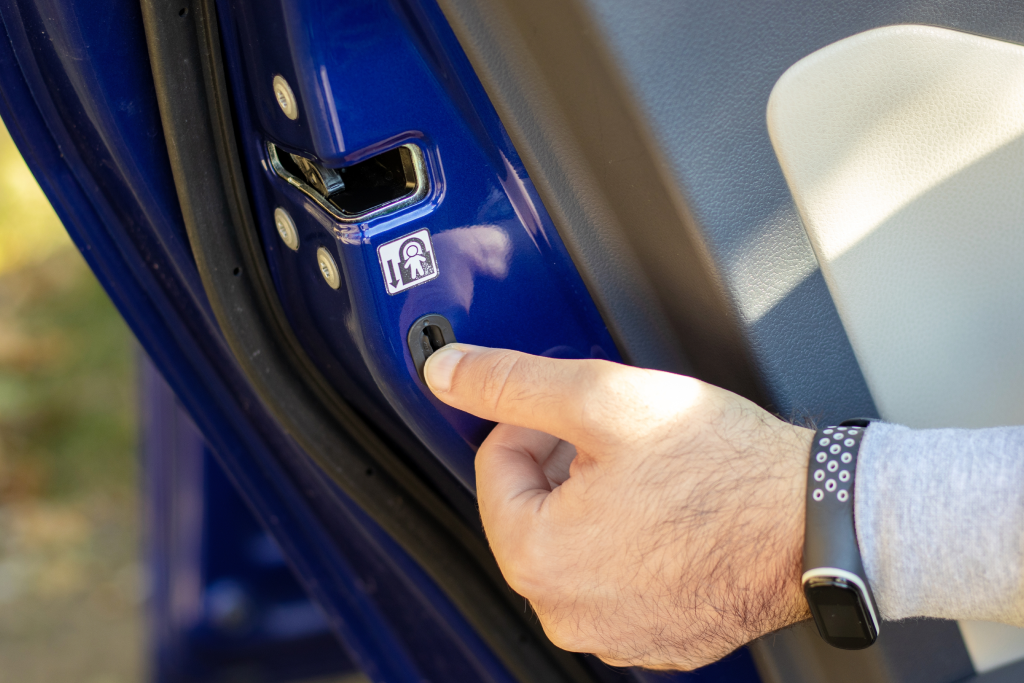
I recommend using child locks if you drive with young children on board. It will prevent the door from accidentally opening while you are driving. Even if your child is seated in a proper car seat and technically not able to unbuckle, it’s safer to use the child lock. It will also bring you the peace of mind to focus entirely on the road.
You can childproof your car by engaging the child and window locks.
- Car child lock: A child lock is available with every car built after the ’70s. It’s a little toggle switch located on the side of the door, only accessible when the door is open. Once the child lock is activated, your kid won’t be able to open the door from the inside. You must open the door manually or use the unlock button on the driver’s door.
- Window lock: The electric window is convenient and much easier to use than the rolling handle. Kids love playing with them too. It’s cute but can be dangerous when driving on the highway. A car with electric windows has a window lock feature. This lock button is accessible on the driver’s side. Once activated, the window will be locked, and your kid won’t be able to play with the window button.
Thinking Outside the Lock: Alternative Childproof Door Solutions
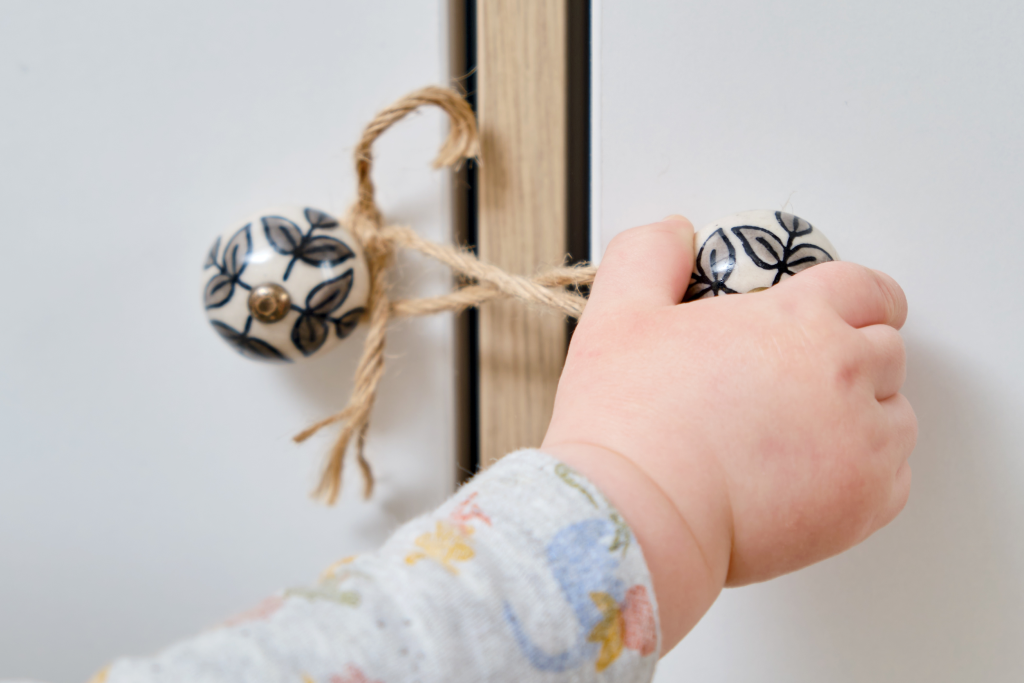
Not every home’s needs are the same, so it’s essential to be aware of alternative childproof door solutions. In this section, we’ll discuss the other options that could be just what you’re looking for.
What are the alternatives to childproof door lock?
Before you get a childproof door lock, look at those alternatives. They could be more appropriate for what you are trying to achieve.
- Baby gates: If you want to prevent your kid from entering a room but don’t want to keep the door closed, you can always use a baby gate. What I like about baby gates compared to child locks is you can keep the door open and prevent your kid from entering too. The air will continue to flow, and the sunlight naturally lights your house. They work great with interior doors. Check out this article dedicated to baby gates.
- Baby monitors: Another great solution to keep an eye on your kid without locking him out of a room is using a baby monitor. With a camera monitor, you can be alert when your kid enters or leaves a room. In some situations, a baby monitor could be your best solution. Learn more about the benefits of video baby monitor here.
- Dutch door: A Dutch door has two panels that can close separately. You can close the bottom part and leave the top open. This kind of door gives you the ability to see and communicate with the people on the other side of the door. It’s kind of a gate, but you still have the option to close the door to have more privacy entirely. This could be an excellent alternative to block kitchen or home office access.
With childproofing measures in place, our job isn’t quite done yet. Let’s talk about safety.
Childproofing Safety Tips: What You Need To Know
Childproofing has its limit, and you must know that it’s not always installing a lock on a door is the best solution. Here’s my advice on how to keep your kids safe and practice smart childproofing.
Is Lock Handles a Good Solution to Keep Kids From Opening Doors?
In most houses, the bathroom door will have a lock handle. You know, the one you can lock with a button.
These are ok to use, but I wouldn’t recommend changing all door handle for this type. The reason is simple, kids love to play with handles and buttons, and they will lock themself inside the room at some point.
If you have one, ensure it has a small hole on the other side. If your kid gets locked inside the bathroom, you must use a toothpick to open the safety mechanism. It will unlock the door from the outside.
Are Cabinet Locks Foolproof?
You or your guest could leave open a cabinet door by accident. It will happen at some point. You must consider the chance you take by keeping dangerous items at your kid’s level.
You should move all dangerous chemicals and sharp or heavy objects to higher cabinets. This way, if you forget to lock the door, there won’t be any chance of a fatal accident.
Lower cabinets, accessible at your toddler height, should still be childproof to avoid an accident or unnecessary mayhem.
Also, remember that cabinet locks are not babysitters. Having a child lock does not mean you should let a kid wander in a kitchen unattended. Doing so will allow them to learn how to unlock the cabinets.
Why You Should Never Let Your Kid See How to Unlock the Cabinets
Your little explorer is watching you unlock the cabinets. He knows those cabinet doors can be opened and wants to know how.
When manipulating the lock, try obstructing your kid’s view or getting his attention elsewhere.
Is Locking My Kid’s Room Door Safe?
As tempting as it could be, locking a child in his room is dangerous. Behind the fact that it’s a little bit cruel, it’s also putting them at risk for no reason. In case of an emergency, they might not get out of the house in time. Also, if something happens to you, you will not be able to get help. Child services or your local fire department will pay you a visit when they learn about it.
The first week my kids were sleeping into a grownup bed, they would always get out of the bedroom. It’s frustrating, I know! But locking them in their room is a terrible idea.
Using a baby monitor or installing a baby gate in their room is more suitable.
Bedtime must stay fun and not become a scene from Alcatraz. It’s time to sleep, not lockdown time!
Conclusion
Make a list of all the doors and drawers you need to childproof. Still, remove as many harmful objects from your kid’s reach and secure the doors with locks. Remember to adapt your childproofing as your kid get older and more curious.
For me, keeping my kids safe while encouraging them to be curious is essential. I also teach them to know the limits and realize what situations can be dangerous.
You must find the right balance between childproofing and common sense. There’s no point in turning your house into Fort Knox. Teaching our kids to be vigilant and accountable for their actions is still the best way to prevent accidents. Sure, in the process, you still need to protect them from serious injuries.
It’s not by putting my kids in bubble wrap that they will learn how to stay safe. It’s by doing some trial and error that we learn the most.
Let’s make sure the error is not too critical.
P.S. Here are the items I’ve used to childproof my home and keep my babies safe. Installing the essential childproofing items will create a safe home for your family.

